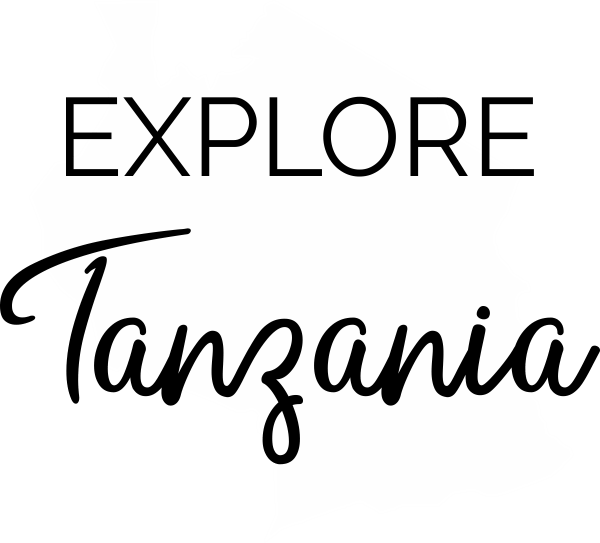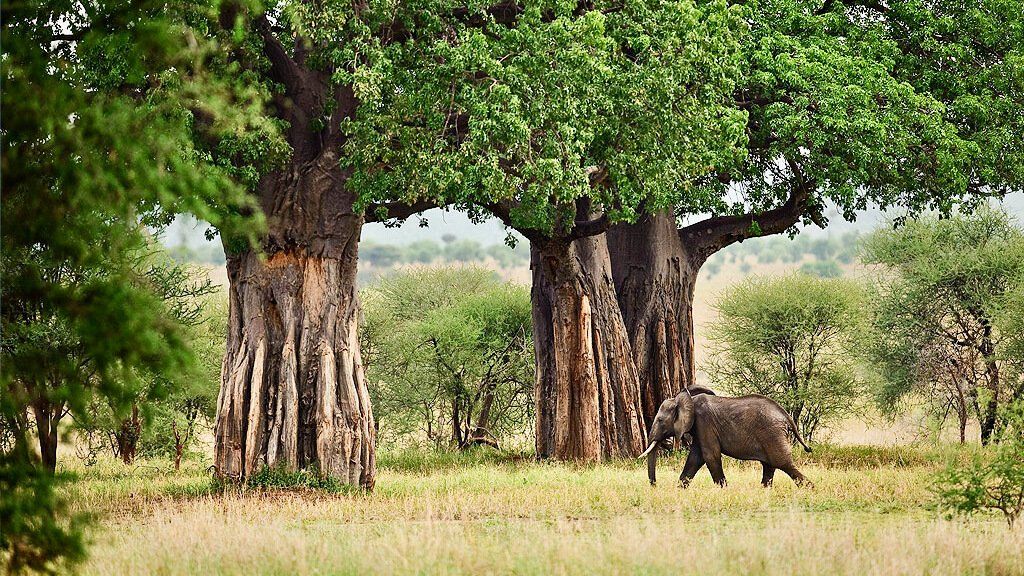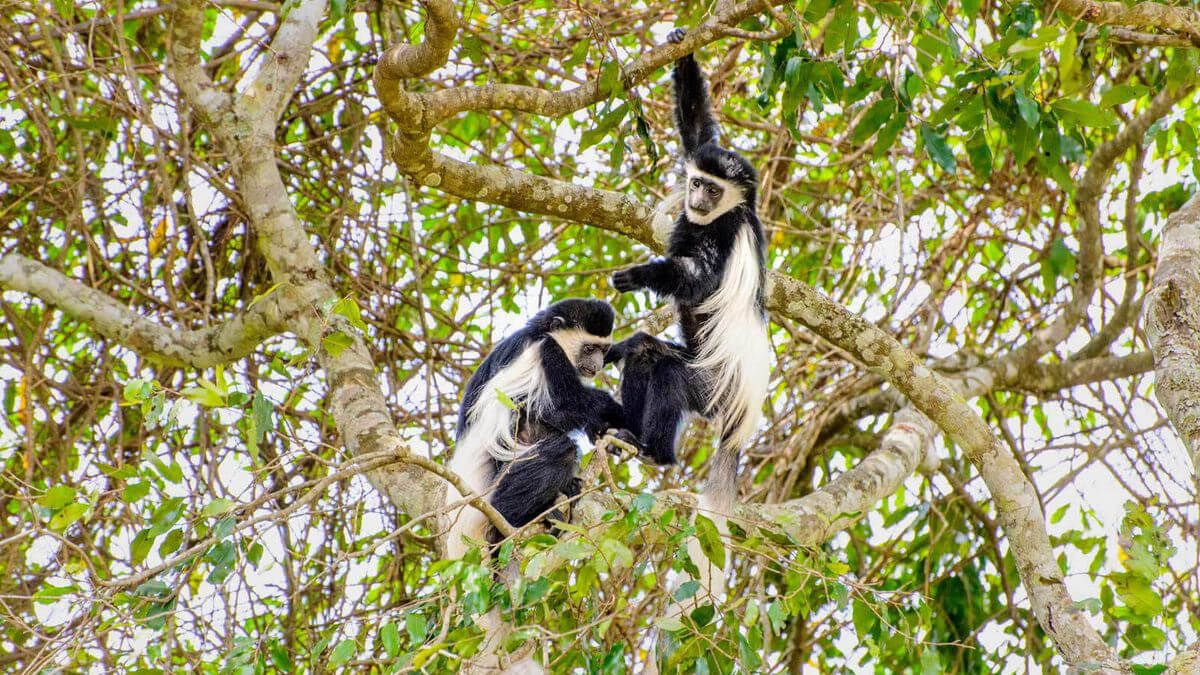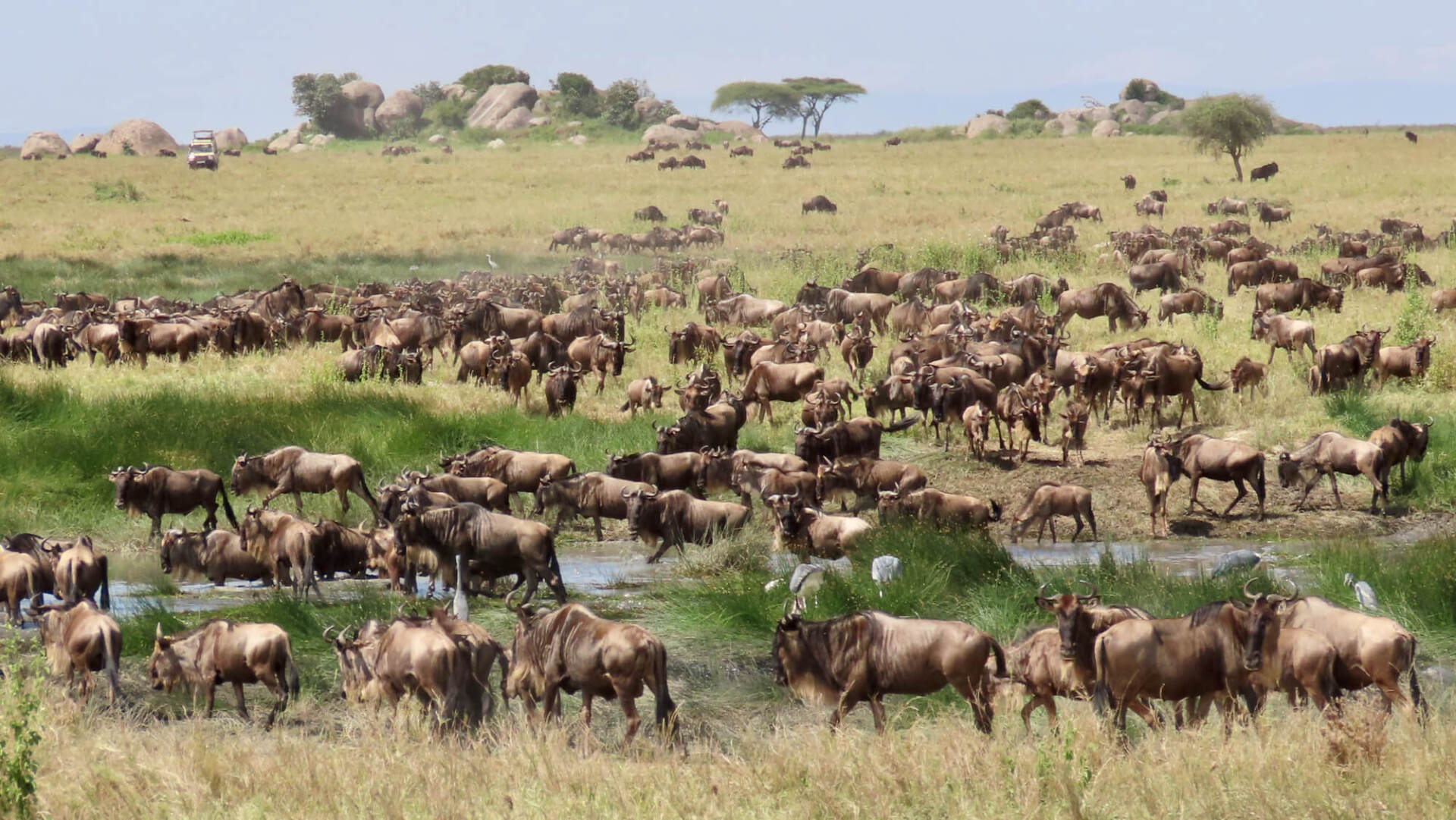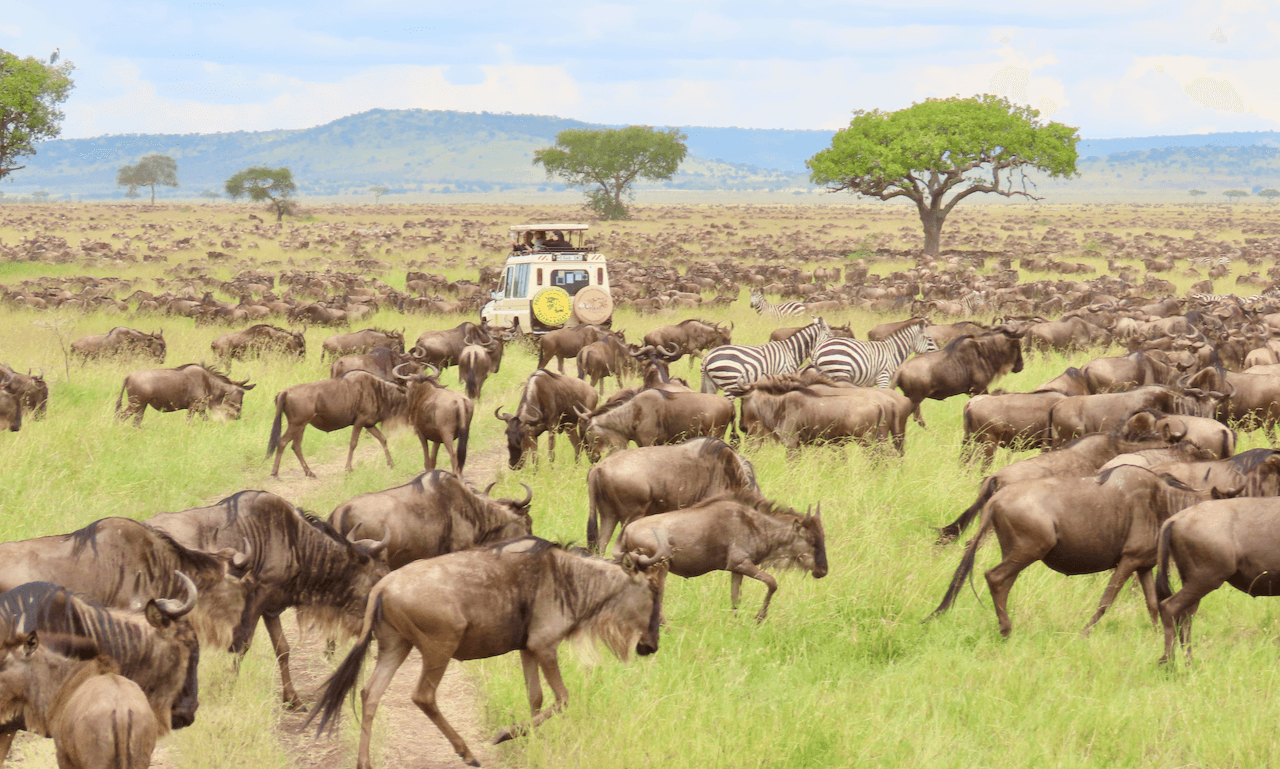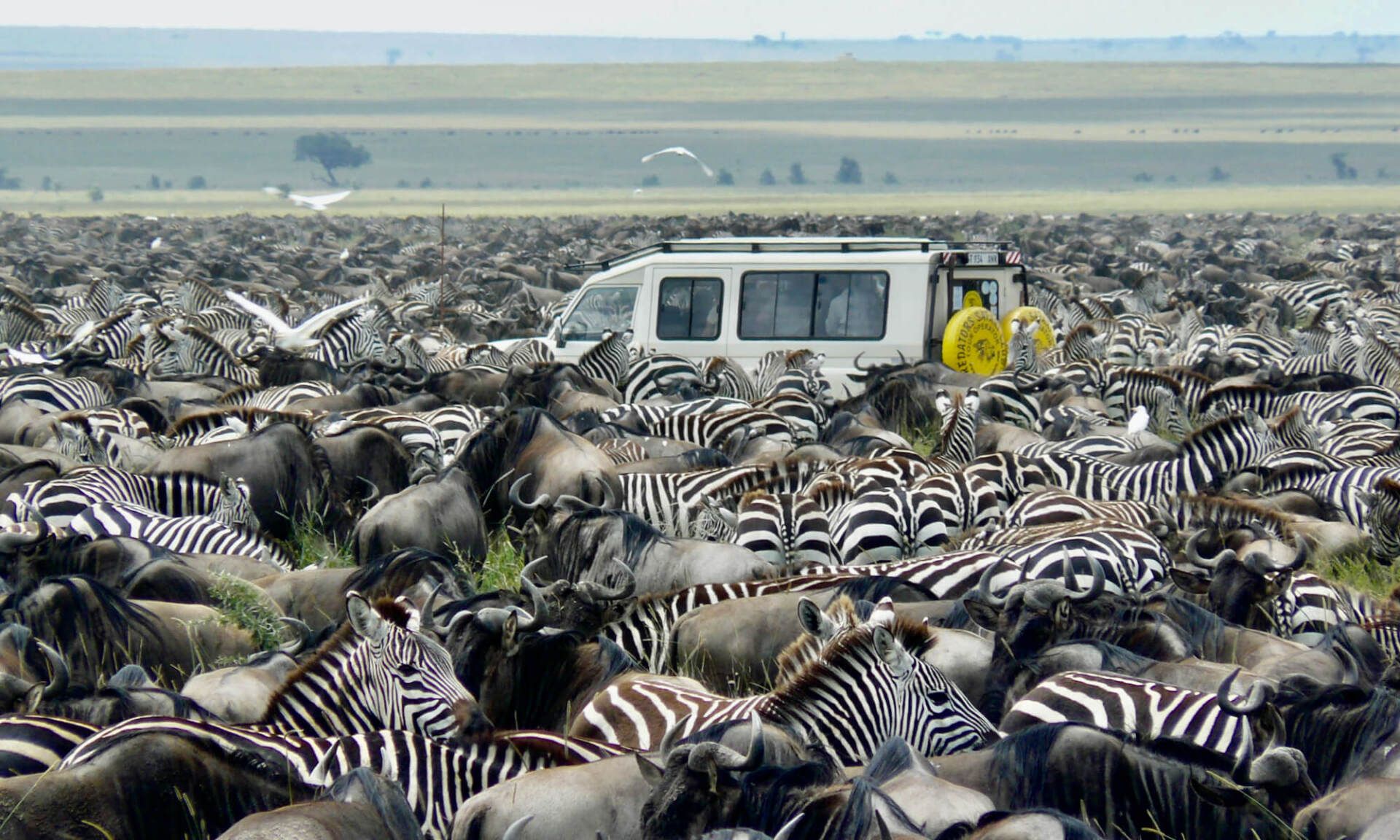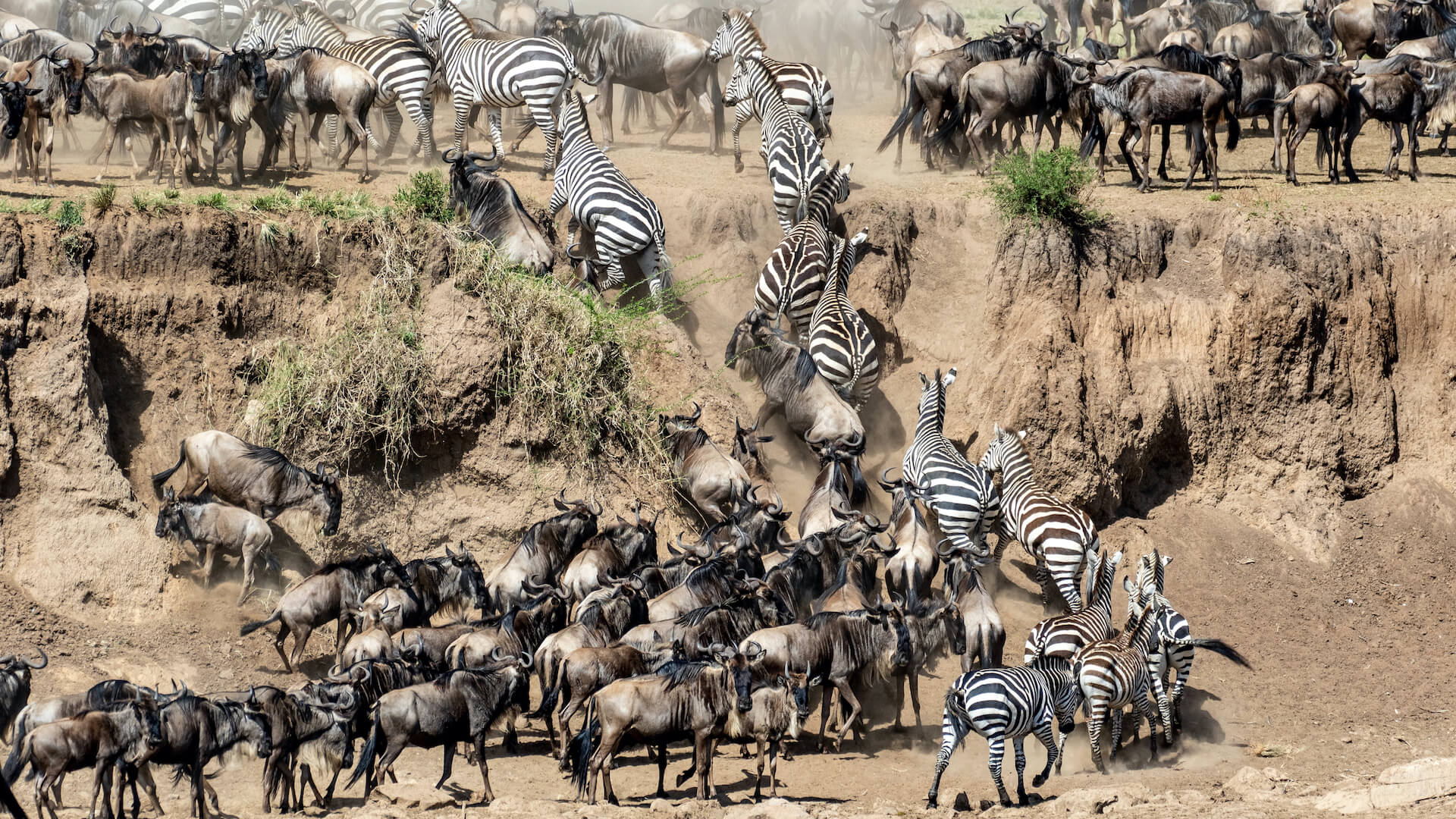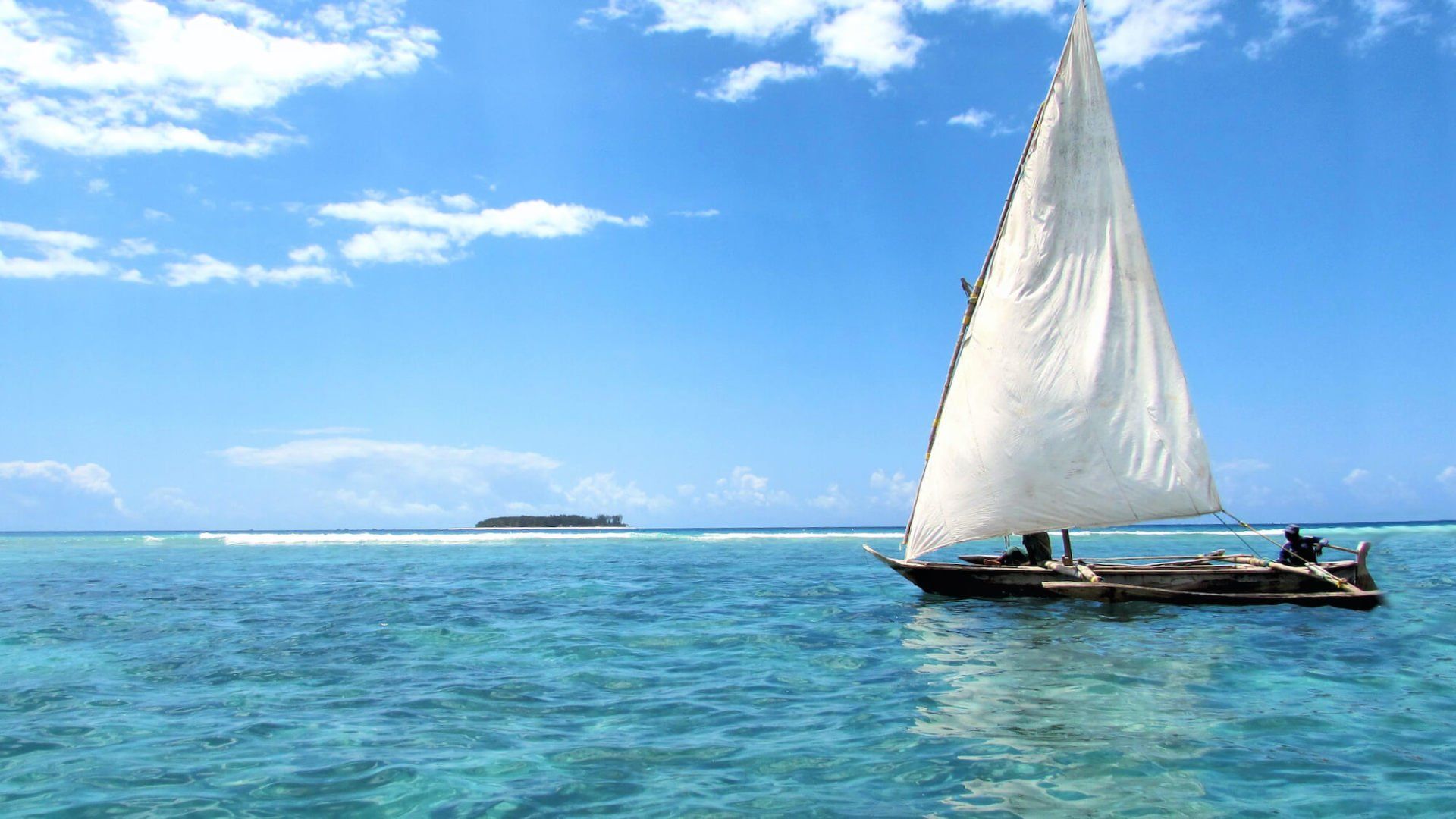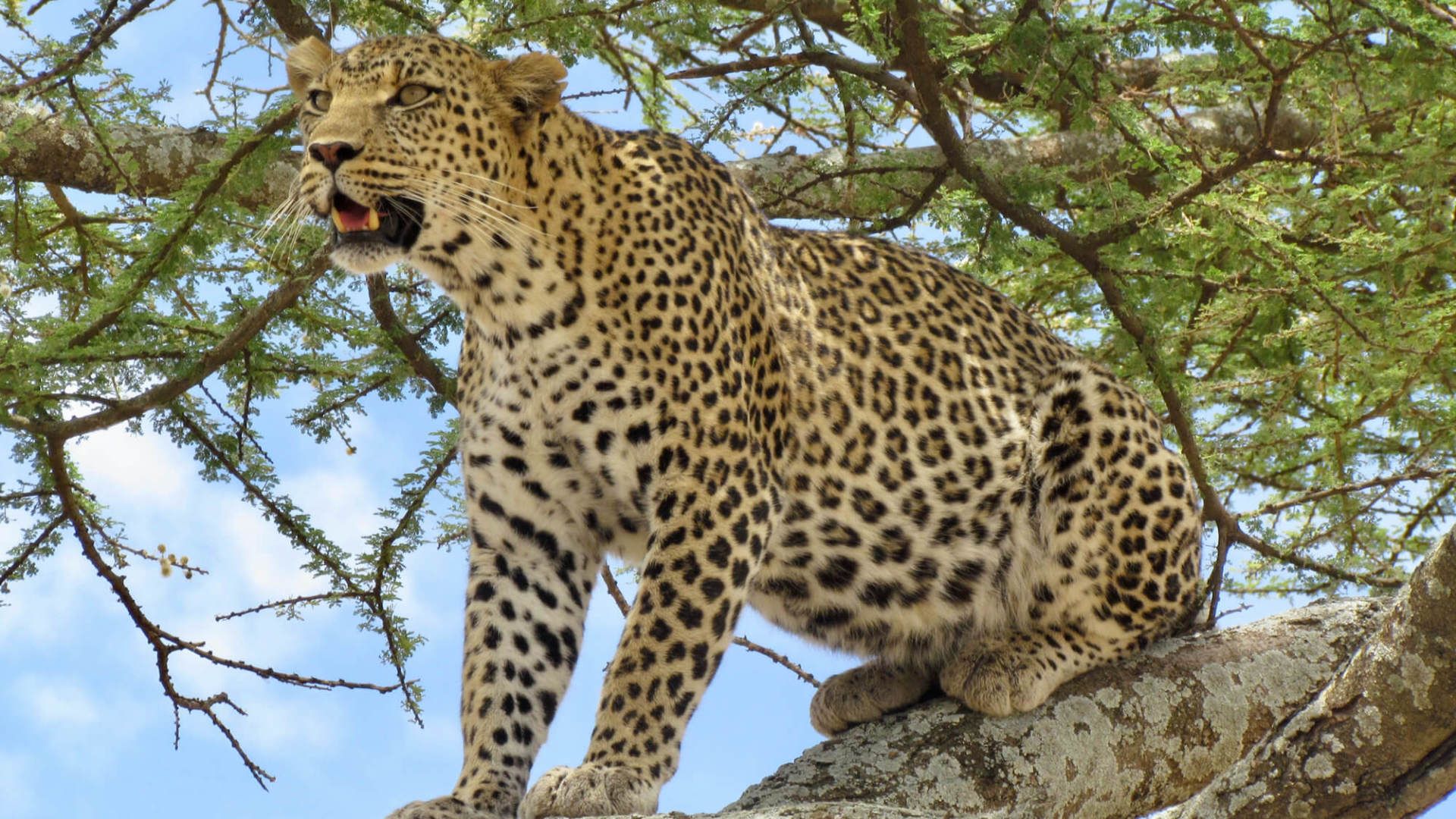Tanzania National Parks
-
Serengeti National Park
Brief profile:
- Covers 14 763 km²
- One of the natural seven wonders of Africa
- The word “Serengeti” originates from the Maasai language and means: “a place where the land goes on forever”
- Serengeti is accessible by vehicle all year round
Highlights:
- One of the world’s greatest wildlife spectacles, the wildebeest migration
- Unforgettable hot air balloon safaris over the vast Serengeti plains
- One of the world’s oldest ecosystems
- Known for its vast grassy plains, dotted with beautiful acacia trees
Being one of the best national parks in Tanzania, the Serengeti’s endless plains is a UNESCO World Heritage Site and is patrolled by Africa’s big cats, elephants, buffaloes, gazelles and giraffes and is perhaps most famous for the migration of animals. The principle players are the wildebeest, whose numbers appear to have increased to about 2 million. In addition, about 250,000 zebras make the seasonal journey to fresh pastures, first to the north, then the south after the rains. Their ancient instinct to move is so strong that no drought, gorge or crocodile-infested river can hold them back. In February the wildebeest cows drop their young in a synchronized birthing that sees some 300 000 to 400 000 calves born within two to three weeks.
Bird watching in the Serengeti is good all year round, at its very best from November to April. This is when European and North African migratory birds are present for resident species.
Best Time to Visit:
| Jan | Feb | Mar | Apr | May | Jun | Jul | Aug | Sept | Oct | Nov | Dec |
|---|---|---|---|---|---|---|---|---|---|---|---|
| Good | Good | Good | Good | Good | Very Good | Very Good | Very Good | Very Good | Very Good | Good | Good |
| Jan | Feb | Mar | Apr | May | Jun | Jul | Aug | Sept | Oct | Nov | Dec |
|---|---|---|---|---|---|---|---|---|---|---|---|
| Good | Good | Good | Good | Good | Very Good | Very Good | Very Good | Very Good | Very Good | Good | Good |
| Jan | Feb | Mar | Apr | May | Jun |
|---|---|---|---|---|---|
| Good | Good | Good | Good | Good | Very Good |
| Jul | Aug | Sept | Oct | Nov | Dec |
|---|---|---|---|---|---|
| Good | Very Good | Very Good | Very Good | Good | Good |
- Tarangire National Park
Brief profile:
- Covers 2 642 km²
- 550 Bird species
- Main roads are good and the landscape is easily accesible
Highlights:
- Tarangire is one of the best places to view elephants in East Africa
- Spectacular baobab trees
- Tarangire is home to more elephants per square kilometre than anywhere else in the world
- Other optional activities include walking safaris and night game drives
Tarangire is made up of low-lying, rolling hills, natural vegetation of acacia woodland and giant baobabs altered by huge areas of swamp. The swamps of black cotton mud produce rich grasslands, while the watercourses are lined by huge trees including sycamore fig, tamarind and sausage trees. Tarangire features some of the greatest concentrations of game in Tanzania, second only to the Ngorongoro crater but with far fewer tourists. There are several dry-country species such as eland, oryx, Grant’s gazelle and gerenuk. These are unlikely to be seen in the bigger parks to the west. Birdlife is plentiful all year round, but bird watching is at its best when the European and North African migratory birds are present (November to April). Nesting among the resident birds takes place during the same time.
Best Time to Visit:
| Jan | Feb | Mar | Apr | May | Jun | Jul | Aug | Sept | Oct | Nov | Dec |
|---|---|---|---|---|---|---|---|---|---|---|---|
| Fair | Fair | Fair | Poor | Poor | Very Good | Very Good | Very Good | Very Good | Very Good | Fair | Fair |
| Jan | Feb | Mar | Apr | May | Jun |
|---|---|---|---|---|---|
| Fair | Fair | Fair | Poor | Poor | Very Good |
| Jan | Feb | Mar | Apr | May | Jun | Jul | Aug | Sept | Oct | Nov | Dec |
|---|---|---|---|---|---|---|---|---|---|---|---|
| Fair | Fair | Fair | Poor | Poor | Very Good | Very Good | Very Good | Very Good | Very Good | Fair | Fair |
| Jul | Aug | Sept | Oct | Nov | Dec |
|---|---|---|---|---|---|
| Very Good | Very Good | Very Good | Very Good | Fair | Fair |
- Lake Manyara National Park
Brief profile:
- Covers 330 km²
- The lake covers two-thirds of the park
- The groundwater forest is a distinctive feature of the park
Highlights:
- Tree-climbing lions
- Large flocks of flamingo on Lake Manyara (Seasonal)
- Herds of elephants
- Stunning forest area
- Exceptional birding opportunities
- Largest concentration of baboons in the world
Located on the edge of the Rift valley, Lake Manyara is a remarkably species-rich reserve, especially known for its birds, elephants, flamingos and tree-climbing lions. En-route to Ngorongoro Crater and the Serengeti, Lake Manyara is well worth a stop in its own right. Its forests, bush plains, baobab-strewn cliffs and hot springs offer an incredible variety in a small area. The alkaline soda lake is home to an amazing array of bird life with the best birding opportunities from November to April. During this time the migratory birds from Europe and Northern Africa can be observed and many birds can be seen in their breeding plumage.
Best Time to Visit:
| Jan | Feb | Mar | Apr | May | Jun |
|---|---|---|---|---|---|
| Good | Good | Fair | Fair | Fair | Very Good |
| Jul | Aug | Sept | Oct | Nov | Dec |
|---|---|---|---|---|---|
| Very Good | Very Good | Very Good | Very Good | Good | Good |
| Jan | Feb | Mar | Apr | May | Jun | Jul | Aug | Sept | Oct | Nov | Dec |
|---|---|---|---|---|---|---|---|---|---|---|---|
| Good | Good | Fair | Fair | Fair | Very Good | Very Good | Very Good | Very Good | Very Good | Good | Good |
| Jan | Feb | Mar | Apr | May | Jun | Jul | Aug | Sept | Oct | Nov | Dec |
|---|---|---|---|---|---|---|---|---|---|---|---|
| Good | Good | Fair | Fair | Fair | Very Good | Very Good | Very Good | Very Good | Very Good | Good | Good |
- Ngorongoro Crater and Conservation Area
Brief profile:
- Covering some 8,300 km²
- One of the natural seven wonders of Africa
- Varying in altitude from 1 020 to 2 285 metres
- The crater is 19.2 kilometres in diameter and 610 metres deep, contains a soda lake and abounds with wildlife
Highlights:
- High concentrations of wildlife offering close-range viewing opportunities
- Big 5 game viewing
- Best place in Tanzania to see black rhino
- Observe Maasai herdsmen graze their cattle adjacent to their predators
- Luxurious lodges perched on the crater rim, offering magnificent views
The Ngorongoro Crater is the world’s largest unbroken volcanic caldera and is regarded as the 8th wonder of the world. It is one of the most diverse and fascinating areas of Tanzania and has been given the status of a World heritage site and International Biosphere Reserve. The fertile slopes and steep forest-covered walls are home to approximately 30,000 animals including the rare black rhino. The various ecosystems found within the 260 square kilometre crater floor sustain Cape buffalo, elephants, wildebeest, zebras, elands, gazelles, hippos, numerous bird species as well as a high concentration of predators. Although birdlife is generally good throughout the year, from November to April, migratory birds from Europe and Northern Africa are present and many resident birds are in breeding plumage.
Best Time to Visit:
| Jan | Feb | Mar | Apr | May | Jun |
|---|---|---|---|---|---|
| Very Good | Very Good | Very Good | Very Good | Very Good | Very Good |
| Jul | Aug | Sept | Oct | Nov | Dec |
|---|---|---|---|---|---|
| Very Good | Very Good | Very Good | Very Good | Very Good | Very Good |
| Jan | Feb | Mar | Apr | May | Jun | Jul | Aug | Sept | Oct | Nov | Dec |
|---|---|---|---|---|---|---|---|---|---|---|---|
| Very Good | Very Good | Very Good | Very Good | Very Good | Very Good | Very Good | Very Good | Very Good | Very Good | Very Good | Very Good |
| Jan | Feb | Mar | Apr | May | Jun | Jul | Aug | Sept | Oct | Nov | Dec |
|---|---|---|---|---|---|---|---|---|---|---|---|
| Very Good | Very Good | Very Good | Very Good | Very Good | Very Good | Very Good | Very Good | Very Good | Very Good | Very Good | Very Good |
- Mount Kilimanjaro National Park
Brief profile:
- Highest mountain in Africa
- The national park covers 1668 km²
- Mount Kilimanjaro comprises three extinct dormant volcanoes (Kibo, Mawenzi and Shira)
- Kibo is the highest at 5,895 metres (the summit of Kilimanjaro)
- Kilimanjaro ranks as one of the world’s “Seven Summits”
- One of the natural Seven Natural Wonders of Africa
Highlights:
- Climbing Kilimanjaro does not require any technical skills or special equipment
- Kilimanjaro is one of the world’s greatest natural wonders – it is a snow-clad mountain on the equator
- Five main vegetation zones from the lowest to the highest point
Kilimanjaro is like the Mona Lisa of East Africa. Towering into the clouds, it has an intriguing majesty about it making it a true beacon in Tazania. As it is one of the highest summits on the planet that can be explored on foot, it attracts visitors from around the world. Most reasonably fit and properly guided climbers can experience the triumph of reaching Uhuru Peak (the actual summit) with little more than a walking stick, warm clothing and sheer determination. A journey up the slopes takes visitors on a climatic world tour, from the tropics to the arctic. The grassy and cultivated lower slopes turn into lush rainforest. Higher still, heath and moorland, covered with giant heathers, becomes a surreal alpine desert and finally, there is ice, snow and the most spectacular view on the continent.
Best Time to Visit:
| Jan | Feb | Mar | Apr | May | Jun |
|---|---|---|---|---|---|
| Good | Very Good | Very Good | Poor | Poor | Very Good |
| Jul | Aug | Sept | Oct | Nov | Dec |
|---|---|---|---|---|---|
| Very Good | Very Good | Very Good | Good | Good | Good |
| Jan | Feb | Mar | Apr | May | Jun | Jul | Aug | Sept | Oct | Nov | Dec |
|---|---|---|---|---|---|---|---|---|---|---|---|
| Good | Very Good | Very Good | Poor | Poor | Very Good | Very Good | Very Good | Very Good | Good | Good | Good |
| Jan | Feb | Mar | Apr | May | Jun | Jul | Aug | Sept | Oct | Nov | Dec |
|---|---|---|---|---|---|---|---|---|---|---|---|
| Good | Very Good | Very Good | Poor | Poor | Very Good | Very Good | Very Good | Very Good | Good | Good | Good |
- Arusha National Park
Brief profile:
- Located only 35 km from Arusha town
- Covers 137 km²
- Offers an audible and visual forest experience
Highlights
- More than 575 species of birds
- Mount Meru - the fourth highest peak in Africa
- Kilimanjaro two-horned chameleons
- Momella lakes
Situated on the eastern edge of the Great Rift Valley, this unique park contains volcanic Momella lakes, the Ngurdoto Crater and Mount Meru, the fourth highest peak in Africa. This little gem of a national park near Arusha, is a perfect place to begin or end your safari. The environment is unique and it contains species that the visitor will not see elsewhere in northern Tanzania. Mount Meru towers over the nearby Arusha town and is topped in Africa only by Mount Kilimanjaro, Mount Kenya and the Rwenzori, all found in East Africa.
Best Time to Visit:
| Jan | Feb | Mar | Apr | May | Jun |
|---|---|---|---|---|---|
| Good | Good | Fair | Fair | Fair | Very Good |
| Jul | Aug | Sept | Oct | Nov | Dec |
|---|---|---|---|---|---|
| Very Good | Very Good | Very Good | Very Good | Fair | Fair |
| Jan | Feb | Mar | Apr | May | Jun | Jul | Aug | Sept | Oct | Nov | Dec |
|---|---|---|---|---|---|---|---|---|---|---|---|
| Good | Good | Fair | Fair | Fair | Very Good | Very Good | Very Good | Very Good | Very Good | Fair | Fair |
| Jan | Feb | Mar | Apr | May | Jun | Jul | Aug | Sept | Oct | Nov | Dec |
|---|---|---|---|---|---|---|---|---|---|---|---|
| Good | Good | Fair | Fair | Fair | Very Good | Very Good | Very Good | Very Good | Very Good | Fair | Fair |
-
Nyerere National Park (Formerly SELOUS)
Brief profile:
- Covers 88 000 km²
- Covering almost six percent of Tanzania’s land surface
- Home to the largest number of animal species found in a single reserve anywhere in the world
- Largest game reserve in Africa
- Only park in Tanzania where game viewing can be done by car, on foot or by boat
Highlights
- Largest remaining wilderness areas in Africa
- Largest population of buffaloes in Africa
- A sixth of the elephant population in Africa is found in Selous
- Biggest concentration of hippo herds on the continent
- Exceptional variety of habitats including Miombo woodlands, open grasslands, riverine forests and swamps
- Boat safaris on the Rufiji river
- Walking safari’s
Located in southeastern Tanzania in a remote and seldom visited part of the country, the Nyerere is Africa's largest protected wildlife reserve, covering almost 6% of Tanzania's total land surface. Due to its remote location, mostly accessible only by small aircraft, the reserve has remained one of the untouched gems of Tanzania. One of the reserve's major attractions is the mighty Rufiji River, the largest river in East Africa and home to one of the largest crocodiles and hippo populations in Africa, swarming with fish which in turn bring about some of the world's best water birding. This wonderfully diverse, vast and well-watered habitat has the right ingredients to enable the land to hold an unusually high number of animals of all shapes and sizes as well as sustain an extraordinary array of different vegetation types. Nyerere has an estimated 2 100 plant species, 350 bird species, 60 000 elephants, 100 000 Cape buffaloes and over a quarter of the worlds’ approximately 4 000 remaining rare wild dogs.
Best Time to Visit:
| Jan | Feb | Mar | Apr | May | Jun |
|---|---|---|---|---|---|
| Good | Good | Fair | Poor | Poor | Very Good |
| Jul | Aug | Sept | Oct | Nov | Dec |
|---|---|---|---|---|---|
| Very Good | Very Good | Very Good | Very Good | Good | Good |
| Jan | Feb | Mar | Apr | May | Jun | Jul | Aug | Sept | Oct | Nov | Dec |
|---|---|---|---|---|---|---|---|---|---|---|---|
| Good | Good | Fair | Poor | Poor | Very Good | Very Good | Very Good | Very Good | Very Good | Good | Good |
| Jan | Feb | Mar | Apr | May | Jun | Jul | Aug | Sept | Oct | Nov | Dec |
|---|---|---|---|---|---|---|---|---|---|---|---|
| Good | Good | Fair | Poor | Poor | Very Good | Very Good | Very Good | Very Good | Very Good | Good | Good |
- Ruaha National Park
Brief profile:
- Covers an area of about 20 226 km²
- Largest national park in Tanzania and also the largest in Africa
- Only park in Tanzania that is home to both the greater and lesser kudu
Hightlights:
- A vast wilderness visited by only a handful of travellers each year
- Lesser and greater kudu co-exist with northern species like the Grant's gazelle
- Known for its elephants and carnivores, especially the African wild dog
- Ruaha is a birder’s paradise, with more than 526 species recorded
- Lions are abundant, leopards and cheetahs are seen frequently
- Ruaha will exceed your expectations
Ruaha National Park is the undiscovered gem of Tanzania and is often called “Tanzania’s best kept secret”. Spectacular landscapes, a huge variety of plant and bird life and an abundance of animals make Ruaha the perfect safari destination. Currently only one-third of the park area is used for tourism leaving the greater majority of wilderness untouched and undiscovered. The central spine of the park is the watershed between the Mzombe and the Great Ruaha River, with its dramatic escarpment covered in large stretches of miombo woodland.
The plains beneath the woodlands has vegetation ranging from dry bush country to treeless grasslands, swamps and evergreen forests intersected by the many sand rivers that are such an impressive feature of this area. Ruaha represents a transition zone where eastern and southern species of flora and fauna overlap and in all and some 1 650 plant species can be found. Ruaha is a bird watcher’s paradise with approximately 526 bird species (more than half of those found in the entire country!).
Best Time to Visit:
| Jan | Feb | Mar | Apr | May | Jun |
|---|---|---|---|---|---|
| Good | Good | Fair | Poor | Poor | Very Good |
| Jul | Aug | Sept | Oct | Nov | Dec |
|---|---|---|---|---|---|
| Very Good | Very Good | Very Good | Very Good | Good | Good |
| Jan | Feb | Mar | Apr | May | Jun | Jul | Aug | Sept | Oct | Nov | Dec |
|---|---|---|---|---|---|---|---|---|---|---|---|
| Good | Good | Fair | Poor | Poor | Very Good | Very Good | Very Good | Very Good | Very Good | Good | Good |
| Jan | Feb | Mar | Apr | May | Jun | Jul | Aug | Sept | Oct | Nov | Dec |
|---|---|---|---|---|---|---|---|---|---|---|---|
| Good | Good | Fair | Poor | Poor | Very Good | Very Good | Very Good | Very Good | Very Good | Good | Good |
SERENGETI MIGRATION GROUP SAFARI
GROUP SAFARI - VERY POPULAR!
8 days / 7 nights
Highlights: Serengeti NP / Ngorongoro Crater / Tarangire NP
Date: April & May 2025
EXPLORER MIGRATION SAFARI
GROUP SAFARI!
7 days / 6 nights
Highlights: Serengeti NP / Ngorongoro Crater / Tarangire NP / Road and fly safari
Date: 07 - 13 May 2025
ULTIMATE SERENGETI MIGRATION SAFARI
SOLD OUT!
GROUP SAFARI!
8 days / 7 nights
Highligts: Serengeti NP / Ngorongoro Crater / Tarangrire NP /
Road & fly safari
Date: 14 - 21 May 2025
TASTE OF TANZANIA SAFARI
GROUP SAFARI - VERY POPULAR!
7 days / 6 nights
Highlights: Serengeti NP / Ngorongoro Crater / Tarangire NP
Date: 12 - 18 May 2025
WILDEBEEST CALVING AND PREDATORS SAFARI
7 days / 6 nights
Highlights: Serengeti National Park / Ngorongoro Crater / Tarangire NP
Date: Private Safari
SERENGETI NORTH MIGRATION
GROUP SAFARI
8 days / 7 nights
Highlights: Serengeti (Central & Northern) / Ngorongoro Crater / Tarangire NP
Dates: 03 - 10 Sep '25 / 06 - 13 Sep '25
ULTIMATE TANZANIA SAFARI
12 days / 11 nights
Highlights: Tarangire / Ngorongoro / Serengeti / Zanzibar
Date: Private Safari
OFF THE BEATEN TRACK SAFARI
8 days / 7 nights
Highlights: Nyerere NP (formerly Selous NP / Ruaha National Park
Date: Private Safari
NYERERE NATIONAL PARK SAFARI
SA RESIDENT SPECIAL
5 days / 4 nights
Highlights: Nyerere National Park
Valid between: Private Safari
BEST OF EAST AFRICA SAFARI
11 days / 10 nights
Highlights: KENYA - Lake Naivasha / Masai Mara / Amboseli NP
TANZANIA - Serengeti NP / Ngorongoro Crater / Lake Manyara
Date: Set departure dates
What Our Clients Say About Our Safaris & Tours
SIGN UP FOR OUR NEWSLETTER
Africa is calling – Sign up to our newsletter today!Get exclusive access to the latest on exclusive offers, getaways and travel inspiration.
Contact Us
We will get back to you as soon as possible
Please try again later
Copyright © 2024 Digital Zoo Website Design Company - All Rights Reserved
Domain Registration
|
Email Address
|
Website Design
|
Graphic Design
|
Social Media Management
|
Search Engine Optimization
|
Online Marketing
|
Web App Developer
All Rights Reserved | Explore Plus Travel & Tours
All Rights Reserved | Explore Plus Travel & Tours

